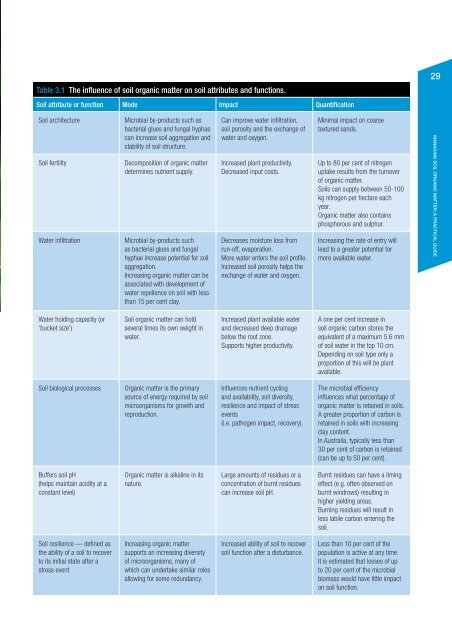managing soil organic matter - Grains Research & Development ...
managing soil organic matter - Grains Research & Development ...
managing soil organic matter - Grains Research & Development ...
Create successful ePaper yourself
Turn your PDF publications into a flip-book with our unique Google optimized e-Paper software.
Table 3.1 The influence of <strong>soil</strong> <strong>organic</strong> <strong>matter</strong> on <strong>soil</strong> attributes and functions.Soil attribute or function Mode Impact Quantification29Soil architectureSoil fertilityWater infiltrationMicrobial by-products such asbacterial glues and fungal hyphaecan increase <strong>soil</strong> aggregation andstability of <strong>soil</strong> structure.Decomposition of <strong>organic</strong> <strong>matter</strong>determines nutrient supply.Microbial by-products suchas bacterial glues and fungalhyphae increase potential for <strong>soil</strong>aggregation.Increasing <strong>organic</strong> <strong>matter</strong> can beassociated with development ofwater repellence on <strong>soil</strong> with lessthan 15 per cent clay.Can improve water infiltration,<strong>soil</strong> porosity and the exchange ofwater and oxygen.Increased plant productivity.Decreased input costs.Decreases moisture loss fromrun-off, evaporation.More water enters the <strong>soil</strong> profile.Increased <strong>soil</strong> porosity helps theexchange of water and oxygen.Minimal impact on coarsetextured sands.Up to 80 per cent of nitrogenuptake results from the turnoverof <strong>organic</strong> <strong>matter</strong>.Soils can supply between 50-100kg nitrogen per hectare eachyear.Organic <strong>matter</strong> also containsphosphorous and sulphur.Increasing the rate of entry willlead to a greater potential formore available water.MANAGING SOIL ORGANIC MATTER: A PRACTICAL GUIDEWater holding capacity (or‘bucket size’)Soil <strong>organic</strong> <strong>matter</strong> can holdseveral times its own weight inwater.Increased plant available waterand decreased deep drainagebelow the root zone.Supports higher productivity.A one per cent increase in<strong>soil</strong> <strong>organic</strong> carbon stores theequivalent of a maximum 5.6 mmof <strong>soil</strong> water in the top 10 cm.Depending on <strong>soil</strong> type only aproportion of this will be plantavailable.Soil biological processesOrganic <strong>matter</strong> is the primarysource of energy required by <strong>soil</strong>microorganisms for growth andreproduction.Influences nutrient cyclingand availability, <strong>soil</strong> diversity,resilience and impact of stressevents(i.e. pathogen impact, recovery).The microbial efficiencyinfluences what percentage of<strong>organic</strong> <strong>matter</strong> is retained in <strong>soil</strong>s.A greater proportion of carbon isretained in <strong>soil</strong>s with increasingclay content.In Australia, typically less than30 per cent of carbon is retained(can be up to 50 per cent).Buffers <strong>soil</strong> pH(helps maintain acidity at aconstant level)Organic <strong>matter</strong> is alkaline in itsnature.Large amounts of residues or aconcentration of burnt residuescan increase <strong>soil</strong> pH.Burnt residues can have a limingeffect (e.g. often observed onburnt windrows) resulting inhigher yielding areas.Burning residues will result inless labile carbon entering the<strong>soil</strong>.Soil resilience — defined asthe ability of a <strong>soil</strong> to recoverto its initial state after astress eventIncreasing <strong>organic</strong> <strong>matter</strong>supports an increasing diversityof microorganisms, many ofwhich can undertake similar rolesallowing for some redundancy.Increased ability of <strong>soil</strong> to recover<strong>soil</strong> function after a disturbance.Less than 10 per cent of thepopulation is active at any time.It is estimated that losses of upto 20 per cent of the microbialbiomass would have little impacton <strong>soil</strong> function.
















